A shuttle boat powered entirely by the sun has been launched on the Serpentine lake in London’s Hyde Park. The 14.5m (48ft) Solarshuttle, thought to be the biggest of its kind in the UK, will carry 42 passengers every half-hour between the north side of the Serpentine and the jetty in the south, near the Princess of Wales memorial fountain. It cruises at 4mph and is silent and pollution-free. When not in use and docked, any surplus electricity generated by the boat’s solar panels will be fed back into the National Grid, they say. Designer Christoph Behling was also behind one of the world’s largest solar boats, the Hamburg Solarshuttle, which now ferries passengers across the city’s harbour.
All posts by The Beetle
Darts in Iran
Darts, the game of throwing small pointed missiles at a board divided into scoring segments is normally associated with British pubs and the consumption of large amounts of alcohol, has found a new following in ultra-conservative Iran. Hundreds of thousands of Iranians, including Muslim clerics and soldiers, are enthusiastically picking up their ‘arras’. Darts brings “happiness and joy and fun at a very cheap price”, according to Masoud Zohouri, head of the Iranian Darts Association.
Daintree Saved
Daintree forest, a World Heritage site in northern Queensland, one of the oldest rainforests on the planet and home to Australia’s most diverse range of species, has been saved from becoming a housing estate. The land was sold off by the state’s maverick Premier Joh Bjelke-Petersen in the early 1980s, and for the last 20 years has been the centre of a battle between developers and environmentalists. At the end of September 2006, the local mayor banned all development in the forest.
MEETING NEWS
MEETING NEWS
Meeting News from London by Padmassana
Our first speaker was Rory Maclean, “The magic bus”, Istanbul to India. Rory set out to visit the places along the classic overland route to India. Starting in Istanbul at the Pudding shop, visiting the spectacular Hagia Sofia, then using mainly public buses to travel through Iran and into Afghanistan, where at one point he landed up at the now infamous Bagram airbase with a group of NGO’s. Along the way Rory bumped into a few of the people who travelled along this way in the 1960’s and never quite made the return journey. Rory’s journey took 5 months, alas “the Magic bus” no longer runs and Afghanistan is once again off limits to all but the most intrepid.
Our second Speaker was Sheila Paine, another of the intrepid bunch who does venture in Afghanistan due to her interest in embroidery and despite being hindered by having to wear a burka to get into the country and travel around managed to capture some great photos of life. Sheila took us to Kandahar, a Taliban town, where the buildings are in ruins and shops have opened inside old shipping containers. At Mazar-I- Sharif we saw some of the beautiful tiled mosques. In the capital Kabul she showed us Chicken Street, a tourist haunt, where a photographer with an old fashioned camera still managed to ply his trade. A fascinating insight into a country we hear only bad news about.
By Padmassana
Coming next: Saturday 4th November 2006
Martin Featherstone will be giving a talk entitled Morocco Off Road. Martin drives into the desert makes discoveries and has adventures. The second talk is to be arranged as David Atkinson’s talk about has been postponed until February.
London meetings are held at The Church of Scotland, Crown Court, behind the Fortune Theatre in Covent Garden at 2.30pm the first Saturday of each month. There is no London meeting in August, but we will be back in September. For more information, you can contact the Globetrotters Info line on +44 (0) 20 8674 6229, or visit the website: www.globetrotters.co.uk
Meeting News from Ontario
For information on Ontario meetings, please contact Svatka Hermanek: shermane@schulich.yorku.ca or Bruce Weber: tel. 416-203-0911 or Paul Webb: tel. 416-694-8259.
Meetings are held on the third Friday of January, March, May, September and November, usually at the Old York Tower, 85 Esplanade (It is at the south-east corner of Church & Esplanade – 2 blocks east from the Hummingbird Centre at 8.00 p.m. Meetings are held on the third Friday of January, March, May, September and November. Usually at the Woodsworth Co-op, Penthouse, 133, Wilton Street in downtown Toronto at 8.00 p.m.
The Golden Triangle and Surrounds
The Beetle visited Thailand in September 2006 and had an opportunity to travel to the Golden Triangle, an area that refers to a large, predominantly highland a Laos, Burma and Thailand and at the point where the Ruak and Mekong Rivers merge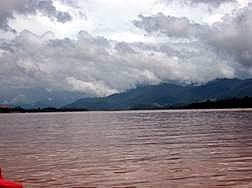 – see picture right of the Mekhong which shows Laos to the right, Burma to the left and Thailand behind.
– see picture right of the Mekhong which shows Laos to the right, Burma to the left and Thailand behind.
For decades this area saw cross-border smuggling and drug production was rampant; the Golden Triangle was once the centre of all opium poppy growing in Thailand. The opium crops have long since been replaced by the small tourist village of Sob Ruak, and today the roads are flanked by countless small restaurants and vendor's souvenir stalls along the banks of the Mekhong river as well as tourist buses.
 Now, the main thing to do in the Golden Triangle area is to take a boat down the Mekhong (see photo above.) There are oodles of long tail boats are available for hire here and you get to wear a life jacket. Cruising up and down the Mekong River allows visitors a glimpse of village life in the many riverside settlements – particularly in Laos where you can step off and for 15 baht visit a small market which sells bootleg cigarettes, snakes inexplicably coiled in whisky jars (see photo below right) and various items of clothing. Technically you are in Laos when on the island and can claim to have visited the country, although you are not allowed to enter into the rest of Laos from there without a visa. There is also a casino, popular with Thais on the left bank going up the Mekhong, on the Myanmar side and it is possible to visit it.
Now, the main thing to do in the Golden Triangle area is to take a boat down the Mekhong (see photo above.) There are oodles of long tail boats are available for hire here and you get to wear a life jacket. Cruising up and down the Mekong River allows visitors a glimpse of village life in the many riverside settlements – particularly in Laos where you can step off and for 15 baht visit a small market which sells bootleg cigarettes, snakes inexplicably coiled in whisky jars (see photo below right) and various items of clothing. Technically you are in Laos when on the island and can claim to have visited the country, although you are not allowed to enter into the rest of Laos from there without a visa. There is also a casino, popular with Thais on the left bank going up the Mekhong, on the Myanmar side and it is possible to visit it. 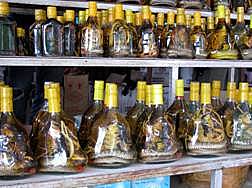
The area's legacy of opium production, usage and trading – which continued right up until the 1980's, is well documented in two museums. Opium production has been illegal in Thailand since 1959. There’s the multi-million dollar museum in Sob Ruak which looks at the history of the area’s association with opium. As you would expect, the museum focuses on opium, opiates, narcotics and drug eradication measures through ‘educational’ displays. The first part of the exhibition details the 5000-year history of opium from its first known appearance in early Egypt, through the 19th century’s opium wars, to the 20th century’s production and trafficking in South East Asia. The second half shows the effects of drugs on the mind and body, describing strategies employed throughout the world to control drugs, international cooperation, and efforts in dealing with drug addiction. The newer and more extensive museum is a little way out of town.
There are several hotels and guest houses in Sob Ruak and it is also possible to organise trekking tours to some of the many hill tribe villages that are located in the outlying areas. About nine kilometres away from Rob Suak is Chiang Saen, once the capital of Lanna which has some ancient, unspoilt temples, including Wat Pa Sak, dating from 1295, where you can see a vast stupa surrounded by smaller temples and chedis. Wat Chedi Luang is also worth visiting, with a large brick chedi that originated in the 14th century. The Chiang Saen Museum exhibits a variety of local artwork, ranging from handicrafts made by people from the surrounding hill tribes, to ancient Lanna-style artefacts.
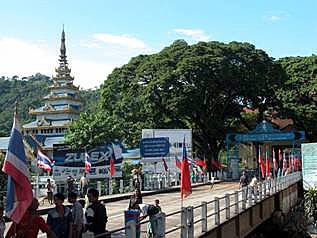 Mae Sai (or Maesai) is the northern most district of Chiang Rai Province in northern Thailand. It is a major border crossing between Thailand and Myanmar, taking you across the Friendship Bridge to Tachileik in Myanmar (see photo left of the Friendship Bridge). Thousands of people cross the border everyday, making this small frontier town filled with people, traffic and various activities, not to mention a street lined with tacky tourist stalls of Thai, Burmese and Chinese origin. Crossing over the border into the Burmese town of Taichilek gives visitors the opportunity to renew their 30-day visa to continue staying in Thailand – though, be warned, there are noises about changing the rules as to how long you can stay in Thailand and how many times you can nip out and renew your visa. Although Taichilek is small and poor Burmese town, with a few attractions, it is popular for its shopping, with a large market offering a variety of inexpensive goods (some of very dubious quality) from China.
Mae Sai (or Maesai) is the northern most district of Chiang Rai Province in northern Thailand. It is a major border crossing between Thailand and Myanmar, taking you across the Friendship Bridge to Tachileik in Myanmar (see photo left of the Friendship Bridge). Thousands of people cross the border everyday, making this small frontier town filled with people, traffic and various activities, not to mention a street lined with tacky tourist stalls of Thai, Burmese and Chinese origin. Crossing over the border into the Burmese town of Taichilek gives visitors the opportunity to renew their 30-day visa to continue staying in Thailand – though, be warned, there are noises about changing the rules as to how long you can stay in Thailand and how many times you can nip out and renew your visa. Although Taichilek is small and poor Burmese town, with a few attractions, it is popular for its shopping, with a large market offering a variety of inexpensive goods (some of very dubious quality) from China.
There are plenty of hotels and guest houses in Mae Sai for all pockets and tastes, though I would not recommend a stay there unless you are caught short by transport problems – it’s not such an interesting place.
The Golden Triangle is most easily accessed from the city of Chiang Rai where there are daily flights from Bangkok. Or you can take a tour or hire a car from Chiang Mai, but it is a long drive and the roads whilst mostly good are windy. An alternative route is via Thaton. The drive along the Mekhong river from Sob Ruak to Chiang Kong is lovely, and you can take a board boat to Luang Prabang in Laos which takes two days.
Lights Out in a Mexican Cave by Ron McCluskey
Shortly after we arrived at our position in Villahermosa, Tabasco, Mexico, my wife and I were invited with a youth group to tour a cave near the town of Pichucalco, Chiapas. It was a warm (read hot) clear day, and even though we did not know much Spanish as yet, we enjoyed the happy enthusiasm of the young people. I was especially interested in watching all the tropical birds along the way. There were tropical species of kingfishers, herons and orioles. There were many interesting tropical plants as well – bougainvillea, elephant ears and bird of paradise flowers.
After about an hour of bouncing along the reasonably good road, we arrived at the parking lot for the cave. You can imagine the hubbub of the young people as they piled out of the bus. We received a short talk about safety and then were off. When we entered the cave, I was surprised to see that the cave was lit with electric lighting. Where I had grown up, there were many caves from volcanic activity, yet I had only been in two caves with lighting before. We slowly made our way back into the cave enjoying the cool that being underground afforded. I was slower than most, because I was taller than most. Cave ceilings and I just don't get along.
After about a half hour, we arrived at the end of the cave where there was a fairly good size room. We stood around for a bit listening to the children’s chatter. Suddenly the lights went out. There was a bit of shrieking at first. We thought it was all part of the tour and expected the lights to come back on any minute. But after a while, still in the pitch dark, we began to wonder. The dark in a cave is pretty dark! You can almost feel it. In broken English, we were made to understand that the lights were not out on purpose. One of the leaders soon started off to the entrance. No lights! He felt his way along and made it out eventually. Over an hour later, we saw a faint light off toward the entrance and were glad to see our fearless leader returning. He had a single flashlight. Hardly enough for the forty or so of us. Soon we had formed a line and were off. Despite warnings of low ceiling, I had numerous bumps and scrapes by the time we saw the sun. We learned our lesson on that trip. Never trust the power. You may need a flashlight when you least expect it.
About the author: Ron McCluskey and his wife Larose are both physicians. Between the two of them they have done volunteer medical work on all continents except Antarctica. Because caring for people's physical needs opens up singular opportunities, they have been able to travel where most others could not. You may find more of their travel experiences at http://ilovetravelvacations.com
The Acropolis of Athens by Matt Barrett
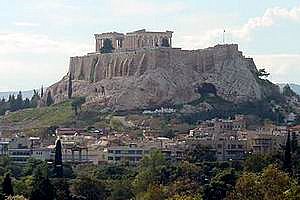 The Acropolis is the one historical site you can't miss. You can take a tour or wander up there yourself but during the summer, whatever you do, unless it is overcast, go early or late in the day. It can get very hot up there and gasping for breath can take way from your ability to marvel at the greatest of all archaeological sites. Getting to the Acropolis is easy and more pleasant than ever because the large avenues which border the south and west of the site (Apostolou Pavlou in Thission and Dionissiou Areopagitou in Makrianni) have been turned into giant pedestrian streets with cafes and restaurants and the walk is quite pleasant. From the Plaka and Monastiraki side it has always been a car-less, enjoyable walk and all you have to do is walk uphill from wherever you are and when you get to the top and there are woods instead of buildings, and steps, take a right.
The Acropolis is the one historical site you can't miss. You can take a tour or wander up there yourself but during the summer, whatever you do, unless it is overcast, go early or late in the day. It can get very hot up there and gasping for breath can take way from your ability to marvel at the greatest of all archaeological sites. Getting to the Acropolis is easy and more pleasant than ever because the large avenues which border the south and west of the site (Apostolou Pavlou in Thission and Dionissiou Areopagitou in Makrianni) have been turned into giant pedestrian streets with cafes and restaurants and the walk is quite pleasant. From the Plaka and Monastiraki side it has always been a car-less, enjoyable walk and all you have to do is walk uphill from wherever you are and when you get to the top and there are woods instead of buildings, and steps, take a right.
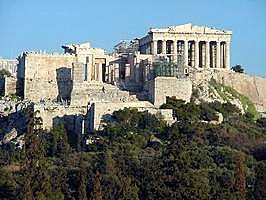 After climbing the steps you are at the entrance, or the Propylaea, which was completed in 432 just before the outbreak of the Peloponnesian wars. The main architect was Mnesicles, a colleague of Phidias. To your left is the Pinacotheca and a Hellenistic pedestal and on the right the tiny temple to Nike Athena or the Athena of Victory which commemorates the Athenians victory over the Persians. This small temple stands on a platform that overlooks the islands of Saronic Gulf and used to house a statue of Athena. It was dismantled by the Turks in 1686 so they could use the platform for a large cannon. It was rebuilt between 1836 and 1842 and again taken apart and rebuilt in 1936 when it was discovered that the platform was crumbing. If you looking from the propylaea towards Pireaus on a clear day you can see ships waiting outside the port of Pireaus, the islands and the mountains of the Peloponessos beyond.
After climbing the steps you are at the entrance, or the Propylaea, which was completed in 432 just before the outbreak of the Peloponnesian wars. The main architect was Mnesicles, a colleague of Phidias. To your left is the Pinacotheca and a Hellenistic pedestal and on the right the tiny temple to Nike Athena or the Athena of Victory which commemorates the Athenians victory over the Persians. This small temple stands on a platform that overlooks the islands of Saronic Gulf and used to house a statue of Athena. It was dismantled by the Turks in 1686 so they could use the platform for a large cannon. It was rebuilt between 1836 and 1842 and again taken apart and rebuilt in 1936 when it was discovered that the platform was crumbing. If you looking from the propylaea towards Pireaus on a clear day you can see ships waiting outside the port of Pireaus, the islands and the mountains of the Peloponessos beyond.
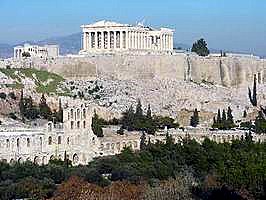 The Parthenon and other main buildings on the Acropolis were built by Pericles in the fifth century BC as a monument to the cultural and political achievements of the inhabitants of Athens. The term acropolis means upper city and many of the city states of ancient Greece are built around an acropolis where the inhabitants can go as a place of refuge in times of invasion. It's for this reason that the most sacred buildings are usually on the acropolis. It's the safest most secure place in town. As little as 150 years ago there were still dwellings on the Acropolis of Athens. Those of you who have read Aristophanes will recall that in Lysistrata the women have Athens barricaded themselves in the fortress in protest, being tired of their men going to war against Sparta. Depriving them of sex, cooking and care it was a terrific strategy that might even work today. Regardless, the play opened the door to the subject of sexual frustration in comedy and without it we might not have Woody Allen. Nowadays there are still protests which occasionally take place by site employees closing the Acropolis to tourists, some of whom have waited a lifetime to come to Greece. Thankfully these are rare and of short duration.
The Parthenon and other main buildings on the Acropolis were built by Pericles in the fifth century BC as a monument to the cultural and political achievements of the inhabitants of Athens. The term acropolis means upper city and many of the city states of ancient Greece are built around an acropolis where the inhabitants can go as a place of refuge in times of invasion. It's for this reason that the most sacred buildings are usually on the acropolis. It's the safest most secure place in town. As little as 150 years ago there were still dwellings on the Acropolis of Athens. Those of you who have read Aristophanes will recall that in Lysistrata the women have Athens barricaded themselves in the fortress in protest, being tired of their men going to war against Sparta. Depriving them of sex, cooking and care it was a terrific strategy that might even work today. Regardless, the play opened the door to the subject of sexual frustration in comedy and without it we might not have Woody Allen. Nowadays there are still protests which occasionally take place by site employees closing the Acropolis to tourists, some of whom have waited a lifetime to come to Greece. Thankfully these are rare and of short duration.
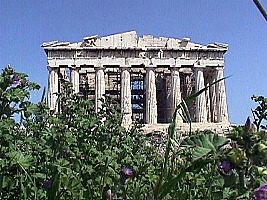 The best time to go up there is the late winter or spring when even this stone mountain is not immune to the proliferation of grass and wildflowers which seem to burst from every crack. Even in December, January and February the Acropolis can be surprisingly green. Even having seen a thousand photographs one is still not prepared for the immensity of the Parthenon. The building was designed by the architects Kallikrates and Iktinos as the home of the giant statue of Athena. It took 15 years to build and was completed in 438 BC and is probably the most recognizable structure in the world next to the golden arches of McDonalds. From a temple it became a church, a mosque and finally as a storage facility for Turkish gunpowder. In 1687 the Venetians bombarded it from below. A cannon ball hit the gun powder and blew it up.
The best time to go up there is the late winter or spring when even this stone mountain is not immune to the proliferation of grass and wildflowers which seem to burst from every crack. Even in December, January and February the Acropolis can be surprisingly green. Even having seen a thousand photographs one is still not prepared for the immensity of the Parthenon. The building was designed by the architects Kallikrates and Iktinos as the home of the giant statue of Athena. It took 15 years to build and was completed in 438 BC and is probably the most recognizable structure in the world next to the golden arches of McDonalds. From a temple it became a church, a mosque and finally as a storage facility for Turkish gunpowder. In 1687 the Venetians bombarded it from below. A cannon ball hit the gun powder and blew it up.
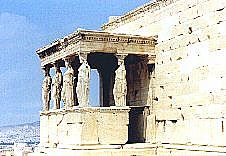 The Erecthion sits on the most sacred site of the Acropolis where Poseidon and Athena had their contest over who would be the Patron of the city. Poseidon thrust his trident into the rock and a spring burst forth, while Athena touched the ground with a spear and an olive tree grew. Athena was declared the victor and the great city of Athens was named for her while Poseidon was given a small village in Syros after it was discovered he had merely ruptured a water main. (not really).The building itself contains the porch of the maidens or Caryatids which are now copies, four of which have been placed in the Acropolis museum, hopefully to be reunited with a fifth taken from the Acropolis by Lord Elgin and put in the British Museum more than a century ago.
The Erecthion sits on the most sacred site of the Acropolis where Poseidon and Athena had their contest over who would be the Patron of the city. Poseidon thrust his trident into the rock and a spring burst forth, while Athena touched the ground with a spear and an olive tree grew. Athena was declared the victor and the great city of Athens was named for her while Poseidon was given a small village in Syros after it was discovered he had merely ruptured a water main. (not really).The building itself contains the porch of the maidens or Caryatids which are now copies, four of which have been placed in the Acropolis museum, hopefully to be reunited with a fifth taken from the Acropolis by Lord Elgin and put in the British Museum more than a century ago.
 A question in my mind is why not rebuild the Parthenon to its former glory? It is not as if the destruction of it is sacred history that must be preserved, in fact the 300 years since the explosion is a relatively short time-span in the history of the building. Much of the Parthenon has been taken apart and put back together with pieces being replaced or clamped to remedy the wear and tear of centuries, in particular the last 20 or so years of air pollution. As it stands now, though it is a tribute to the glorious past and the achievement of the Ancient Athenians it is also at the same time a reminder that whatever is good in man is eventually overcome by ignorance, war and a hunger for domination. I say rebuild the entire Acropolis as an inspiration that whatever is wrong with the world can be righted. (Until some idiot blows it up again).
A question in my mind is why not rebuild the Parthenon to its former glory? It is not as if the destruction of it is sacred history that must be preserved, in fact the 300 years since the explosion is a relatively short time-span in the history of the building. Much of the Parthenon has been taken apart and put back together with pieces being replaced or clamped to remedy the wear and tear of centuries, in particular the last 20 or so years of air pollution. As it stands now, though it is a tribute to the glorious past and the achievement of the Ancient Athenians it is also at the same time a reminder that whatever is good in man is eventually overcome by ignorance, war and a hunger for domination. I say rebuild the entire Acropolis as an inspiration that whatever is wrong with the world can be righted. (Until some idiot blows it up again).
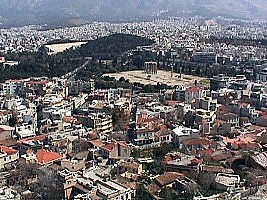 My favourite spot is at the flag where Athens stretches out endlessly below. You can see the Plaka beneath you, the ruins of the giant Temple of Olympian Zeus and the Olympic stadium nestled in a pine covered hill, an island of green in a sea of concrete. To the left of the stadium is the Zappion building and the National Gardens. To the right of the stadium you can see another large patch of green which is the First Cemetery. The Acropolis is a great place to get your bearings and get an understanding of the layout of the city. In fact the more you know Athens the more interesting it is to come up here and see familiar landmarks.
My favourite spot is at the flag where Athens stretches out endlessly below. You can see the Plaka beneath you, the ruins of the giant Temple of Olympian Zeus and the Olympic stadium nestled in a pine covered hill, an island of green in a sea of concrete. To the left of the stadium is the Zappion building and the National Gardens. To the right of the stadium you can see another large patch of green which is the First Cemetery. The Acropolis is a great place to get your bearings and get an understanding of the layout of the city. In fact the more you know Athens the more interesting it is to come up here and see familiar landmarks.
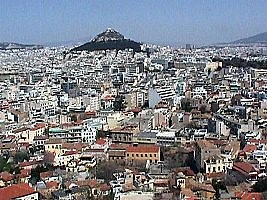 If you stand by the flag and look to your left you will see Mount Lycabettos rising from the neighbourhood of Kolonaki , with the Hilton and the Athens Tower at Ambelokipi in the distance. The large green area is the National gardens. The Acropolis is a great place to get your bearings in Ath
ens. Y
ou can see as far as Kifissia on a clear day.
If you stand by the flag and look to your left you will see Mount Lycabettos rising from the neighbourhood of Kolonaki , with the Hilton and the Athens Tower at Ambelokipi in the distance. The large green area is the National gardens. The Acropolis is a great place to get your bearings in Ath
ens. Y
ou can see as far as Kifissia on a clear day.
When the Germans occupied Athens in WWII, the Evzone who guarded the Greek flag which flew from the Acropolis, was ordered by the Nazis to remove it. He calmly took it down, wrapped himself in it and jumped to his death.
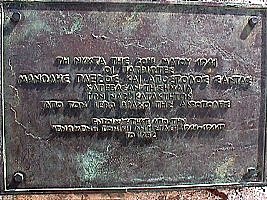 The plaque by the flag commemorates Manolis Glezos and Apostolis Santas, the two eighteen year-old heroes who tore down the Nazi flag flying from the Acropolis on the night of May 30th, 1941. It is of particular interest because these names are known not only by Greeks, but by many Europeans, because this act of courage and resistance to Nazi oppression was an inspiration to all subjected people. Later through reading the book Athens: The City by John Tomkinson I found out that Glezos, who became a member of the Greek resistance, was condemned to death for treason in 1948 and imprisoned for being a communist. He was later elected a member of the Panhellenic Socialist Party (PASOK).
The plaque by the flag commemorates Manolis Glezos and Apostolis Santas, the two eighteen year-old heroes who tore down the Nazi flag flying from the Acropolis on the night of May 30th, 1941. It is of particular interest because these names are known not only by Greeks, but by many Europeans, because this act of courage and resistance to Nazi oppression was an inspiration to all subjected people. Later through reading the book Athens: The City by John Tomkinson I found out that Glezos, who became a member of the Greek resistance, was condemned to death for treason in 1948 and imprisoned for being a communist. He was later elected a member of the Panhellenic Socialist Party (PASOK).
 Below the Acropolis is the theatre of Herod Atticus built by the Romans in 161 AD and still used today for classical concerts, ballet, performances of high cultural value and Yanni. Further on is the Theatre of Dionysius the first stone theatre and home to Sophocles, Aeschylus, Euripides and Aristophanes. It was rebuilt around 342 BC by Lykourgos and then enlarged by the Romans to be used for gladiator fights. In July of 2003 I saw Jethro Tull here. It was the first rock concert held in the ancient theatre and though perhaps some people hope it was the last I would be happy to see more. How about Deep Purple with the Royal Philharmonic Orchestra performing Jon Lord's Concerto for Group and Orchestra? Maybe Procul Harum? Emerson, Lake and Palmer? The Stooges? Where's Leonard Cohen when you really need him?
Below the Acropolis is the theatre of Herod Atticus built by the Romans in 161 AD and still used today for classical concerts, ballet, performances of high cultural value and Yanni. Further on is the Theatre of Dionysius the first stone theatre and home to Sophocles, Aeschylus, Euripides and Aristophanes. It was rebuilt around 342 BC by Lykourgos and then enlarged by the Romans to be used for gladiator fights. In July of 2003 I saw Jethro Tull here. It was the first rock concert held in the ancient theatre and though perhaps some people hope it was the last I would be happy to see more. How about Deep Purple with the Royal Philharmonic Orchestra performing Jon Lord's Concerto for Group and Orchestra? Maybe Procul Harum? Emerson, Lake and Palmer? The Stooges? Where's Leonard Cohen when you really need him?
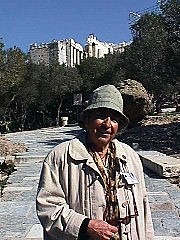 You may notice at the entrance to the Acropolis and the paths leading up to it the licensed guides who for around 50 Euros or so, will give you a tour so that you may leave the area more informed then when you got here. One of the most well-known was Teresa Mitsopoulou, an Archaeologist and writer of some renown. Several of her books are considered controversial by her fellow archaeologists because they seem to prove a link between Chinese and Ancient Greek culture that if correct could change much of what we believe about the past. Theresa has gotten older now and cannot climb the ancient hill as quickly and as easily as she once used to. But she has been described by one travel agent as “… to the Parthenon, what an old monk is to a monastery. If one has the time and patience to sit with her much can be gained. She has been a licensed Acropolis Guide since 1954, in my view a contemporary priestess”. See Theresa's website at www.greecetravel.com/archaeology/mitsopoulou
You may notice at the entrance to the Acropolis and the paths leading up to it the licensed guides who for around 50 Euros or so, will give you a tour so that you may leave the area more informed then when you got here. One of the most well-known was Teresa Mitsopoulou, an Archaeologist and writer of some renown. Several of her books are considered controversial by her fellow archaeologists because they seem to prove a link between Chinese and Ancient Greek culture that if correct could change much of what we believe about the past. Theresa has gotten older now and cannot climb the ancient hill as quickly and as easily as she once used to. But she has been described by one travel agent as “… to the Parthenon, what an old monk is to a monastery. If one has the time and patience to sit with her much can be gained. She has been a licensed Acropolis Guide since 1954, in my view a contemporary priestess”. See Theresa's website at www.greecetravel.com/archaeology/mitsopoulou
Acropolis Information
The Acropolis is open from 8am to 6:30 pm every day. These hours can change depending on the season and sometimes it is open in the evening of the full moon in the summer. They don't allow you to bring backpacks or day bags on the Acropolis. You have to check them so if you need to bring a bag with you be sure to have a spare pocket for your valuables. The cost of entrance to the Acropolis is about 12 euros and is good for the other sites in the area including the ancient agora, theatre of Dionysos, Kerameikos, Roman Agora, Tower of the Winds and the Temple of Olympian Zeus and is supposedly good for a week. You can also buy individual tickets to these other sites. One way to get to the Acropolis is to walk up from the Plaka and keep climbing until you come to the small road that goes around it and head west (to your right). The entrance is up from the rock of Areopagos. The easiest way is to follow Dioysiou Aeropagitou, the large pedestrian street that starts near Hadrian's Arch and goes around the north of the Acropolis until you come to the marble paths that lead up the hill. This road becomes Apostolou Pavlou which is also car-less and continues past the cafes of Thission to the lower Ermou and Kerameikos archaeological site which is at the bottom of Monastiraki.
Matt Barrett is a travel writer who specializes in Greece. His Greece Travel Guides at www.greecetravel.com are considered among the best on the internet with enthralling photos and entertaining writing while at the same time being very informative. He also answers questions about Greece by e-mail at matt@greecetravel.com
Planning for the Family Holiday by Kirsa Guidan
So you are ready to start planning that family vacation that you have been putting off for a few extra months. And you feel like you need a pat on the back for that special task. A family holiday is a bit of effort for the workaholics of this world so it's understandable. Planning a trip should be exciting though, so dig in and make it a fun time for all parties involved!
Children and teenagers alike will appreciate being included in the planning of the family vacation. The keyword here is family so try to include everyone on the travel plans. Ask the questions that will generate numerous ideas to consider. Where does the gang want to go? How about the Great Smoky Mountains? Your family will love Gatlinburg and Pigeon Forge. Cherokee, North Carolina isn't far from the park in Gatlinburg which offers the non-stop casino action of Harrah's Cherokee Smoky Mountain Casino. Even though it's a family vacation, there are lots of activities for children to do in the Cherokee area that can enable mom and dad some grown-up time in the casino. Teens love the extensive white water rafting and tubing in and around Cherokee.
If you think that the Smoky Mountains will be a fun time for the family, then plan on several days in Pigeon Forge, several days in Gatlinburg and take a day to go to Cherokee and Maggie Valley. If you have never visited the area, there's a lot to see and do. Dollywood and Dixie Stampede will keep children and teens thrilled in Pigeon Forge while the shopping in Sevierville and Pigeon Forge will thrill mom while dad finds the golf courses to excite his golfing ambitions! There's something for the family in the Great Smoky Mountains of Tennessee.
Family travel may lead you to the beach this year and there are so many to choose from in the US that it is hard to single out just one. For starters, there are the gorgeous beaches of Florida. On the gulf, no other beach is as beautiful as the beaches on St.George Island. Long before the hurricanes inflicted damage on the beaches of Destin and the surrounding areas, the best kept Florida gulf secrets were savoured in St.George Island. Then the hurricanes over the last couple of years knocked Destin for a loop. Hurricane Katrina didn't take a direct hit in Destin but smaller storms have certainly deteriorated some of the more gorgeous areas of Destin. Now, beach lovers search the beaches of St. George Island. Families love the sugary white sand and the lovely homes which are available for rental at any time during the year.
Daytona Beach and Melbourne Beach on the East Coast in Florida are still favourites among families who have surfers to consider. The beaches offer so much family fun that you will never want to leave the beach to go out for dinner! However, if you travel to Melbourne, watch out for the local fishermen who like to fish from the sandy beaches in front of the local hotels. You can count on numerous small sharks swarming when these guys start fishing in the area. Still, the surfing is great in these areas so get ready to surf with the best!
Malibu Beach is still the beach you must see when your travels take you to California. Family vacations in California tend to excite everyone, except Californians maybe! Disneyland is also a California favourite and families love all of the recent additions to the original Disney Theme park!
Family vacation planners may opt for an all inclusive cruise for the family! Carnival Cruise Lines offer the best vacations for the multi-interests of the family. Norwegian Cruise lines and the cruising offered by Royal Caribbean offer plenty of vacation options. Travellers will find that they have so many activities on board for everyone that they may want to divide up so everyone can explore their own niche all on their own. Still, the travelling family can join back up around some awesome dining options later in the day which is some of the best cuisine you'll find. Never mind the meals are on water, the ice sculptures of these vessels make for interesting dining conversation and the younger children being cared for while mom and dad enjoy a night-out makes for a fun family vacation to be had by all!
Another idea for fun family vacations are the vacations that are the once in a lifetime vacations that your children will hold dear to them all of their lives. Take the time to rent an RV, if you don't have one, and see the entire US by camping all over the United States. If you prefer motels and hotels, then travel across America and offer your children a variety of places to stay. Check out some bed and breakfasts for a quick overnight stop. Then, go spend a few days in a hotel which caters to children like the lodging opportunities in Sandusky, Ohio where indoor water parks allow the parents plenty of time to sit back and read a long awaited novel while the children run wild and wet in the indoor pools of Sandusky, Ohio.
Explore State Parks and the Great Lakes, Visit Hershey, Pennsylvania and see the Amish Country. Go to the Big Apple, travel through Chicago and visit the Heart of America, the Heartland of America that is by visiting all of the pleasures of the Mid-West. See the beauty of Oregon and Washington State and find a nice country dude ranch in Colorado while you and your family find out how it feels to live in the wild old west!
Family travel has never been so easy to plan on your own with the internet at everyone's fingertips. Have the entire family pull up a chair to the computer and put your heads together for a fun-filled evening planning the greatest family vacation your family has ever had!
Kirsa Guidan is the owner of Travel Yak, a premier resource for travel information.
Suvarnabhumi – Bangkok’s New Airport
Southeast Asia's largest airport, Suvarnabhumi officially opened at the end of September after over forty years of planning and building that at a cost if US $4 billion converted a swamp into a huge complex the size of a small city. On the whole, passenger feedback has been reported as favourable. The new airport replaces Don Muang, an overcrowded, dark and dirty airport with a golf course stuck between the runways.
The new airport has a massive departure hall similar to that in Hong Kong and Kuala Lumpur. First class and business passengers have separate check-in areas complete with leather couches. Once you get through the immigration control, you are confronted with a large statue of a snake being pulled in two directions by opposing factions. Padmassana says that it depicts the Hindu legend of the churning of the milk ocean. Many travellers line up to have their photos taken against it.

Teething problems included some delays as computer check-in systems crashed and heavy rain revealed small leaks and passengers on the first arriving flight waited more than an hour for their baggage. But officials said most of the systems at the airport, known as Suvarnabhumi, or “golden land”, performed up to expectations.
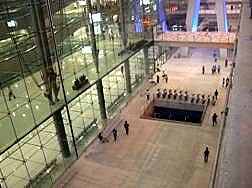 The exterior is made up of huge glass sheets, lit up in blue neon at night. Approaching the airport
The exterior is made up of huge glass sheets, lit up in blue neon at night. Approaching the airport 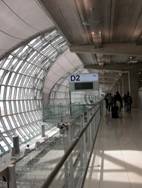 by taxi, it looks a little like a series of low level Sydney Opera houses with beige coloured caterpillar sections fitting together like four extended arms. Inside, it is vast with massive walkways of shops and food outlets, some of which are surprisingly good value, for an international airport.
by taxi, it looks a little like a series of low level Sydney Opera houses with beige coloured caterpillar sections fitting together like four extended arms. Inside, it is vast with massive walkways of shops and food outlets, some of which are surprisingly good value, for an international airport.
When the Beetle passed through Suvarnabhumi, there were still pieces of wire and assorted building detritus on the floor and when you looked up they had fallen from open hatches in the ceiling. There were workers in their hundreds still sawing marble or wood in various parts of the airport. Some parts of the airport clearly remain unfinished: the parking lot is a concrete shell, many airport lounges will not be completed before the end of the year and a light rail train connecting the airport to the city centre is not due for completion before November 2007, some say 2008. If anything, the major criticisms appear to centre around the fact that it is still difficult to get to the new airport except by private car or taxi rather than the airport not being quite finished on its opening.
With an annual capacity of 45 million passengers, Thai officials hope Suvarnabhumi will help surpass Hong Kong as a regional air hub. Last year, Bangkok had 39 million passengers, slightly fewer than the 40 million who used Hong Kong's airport. Singapore, another hub, had 32 million passengers and recently completed a renovation of one of its terminals.
The World's Top Tourism Destinations
The World’s Top Tourism Destinations
|
2004 rank |
Country |
Arrivals (millions) |
Percent change 2004/2003 |
Market share 2004 |
||
|
2002 |
2003 |
2004 |
||||
|
1. |
France |
77.0 |
75.0 |
75.1 |
0.1% |
9.8% |
|
2. |
Spain |
52.3 |
51.8 |
53.6 |
3.4 |
7.0 |
|
3. |
United States |
43.6 |
41.2 |
46.1 |
11.8 |
6.0 |
|
4. |
China |
36.8 |
33.0 |
41.8 |
26.7 |
5.5 |
|
5. |
Italy |
39.8 |
39.6 |
37.1 |
-6.4 |
4.9 |
|
6. |
United Kingdom |
24.2 |
24.7 |
27.8 |
12.3 |
3.6 |
|
7. |
Hong Kong (China) |
16.6 |
15.5 |
21.8 |
40.4 |
2.9 |
|
8. |
Mexico |
19.7 |
18.7 |
20.6 |
10.5 |
2.7 |
|
9. |
Germany |
18.0 |
18.4 |
20.1 |
9.5 |
2.6 |
|
10. |
Austria |
18.6 |
19.1 |
19.4 |
1.5 |
2.5 |
(international tourist arrivals) source: http://www.infoplease.com/ipa/A0198352.html
Mac's Travel Reminiscences
 Mac is still not very well but is still e-mailing strong. In this month’s Globetrotter e-newsletter, he writes about animals.
Mac is still not very well but is still e-mailing strong. In this month’s Globetrotter e-newsletter, he writes about animals.
Just read in todays Washington Post about the 12,000 elephants in Kruger National Park, South Africa. The park is enormous. I had written in my notes that it was as large as Texas (I always exaggerate) but paper says nearly as large as New Jersey. I spent several wonderful days there. On back of picture postcard I wrote Kruger Park, South Africa 12 Nov 1988 : I have seen zimbas (lions), Oliphants (elephants) and mosquitoes. The Park is bigger than some countries. We get up at 5AM tomorrow to look for more oliphants. In my notes I wrote: a baby elephant weighs 50 lbs at birth and is pink the first day so it is possible to see a pink elephant. It starts turning grey the second day. It is also possible to see a drunken elephant; they are fond of Marula fruit berry which has some alcohol content that can make them tipsy. I am starting a local chapter of AA (alcohol anonymous) and am trying to get a friend of mine who is a AA member to talk to them. They are 7500 of them (now 12,00) (all drunk.)
Our guide says that a baby giraffe is born landing on it feet and can immediately run 40 miles an hour (according to the guide) to catch up with its mother. Rhinoceros have very good hearing but poor eye sight. Many were wearing glasses. The paper says that elephants often live to be 60 years old but that they are not eligible to come to the Old Soldiers Home. They play, they mourn, and they eat. They eat more than 300 pounds of leaves, bark and grass a day. “Elephants often look directly into the eyes of humans and flap their giant ears.” The paper says they may have to cull (kill) some so there is space and food for other animals in the Park.
I met in South Africa a young American whose father was a friend of the head man at Kruger and staying with him. The American was getting a degree in ecology or something. They told me they were culling elephants then. For same reason I was cross and said in Kenya when I was there they were short of elephants because of drought and couldn’t they mail some to Kenya. They said this was not practical (postage too high.) They said I did not see the whole picture and to keep my mouth shut about the culling. Now I find they had been culling (killing) more than 14,000 of its elephants between 1967 and 1994 until an animal rights groups demanded a moratorium.
In Kenya I had stayed at Salt Lick Lodge built up on stilts so that elephants and other animals could walk underneath. There was a skull of an elephant where you deposited your room key. Before retiring each night you told them at the desk which animals you wanted to be awakened to see if they came to the water hole nearby. I put down, “Everything but mosquitoes.” In the middle of the night someone was knocking at my door and shouting elephants! Groggy with sleep I did not know where I was and was wondering why someone was at my door hollering “Elephants.” At Alddo Game Reserve (also in South Africa, smaller than The Kruger and the elephants are also smaller) they used to feed the elephants citrus fruit and apples at 4.30 pm. There is a travel book called Elephants Arrive at Half Past Four, but they have quit doing this as they want the elephants to take care of themselves so they now issue them food stamps. I love elephants.
I read in National Geographic 2000 (I am a little behind in my reading.) My Father used to be a butcher. One day he backed into the meat grinder and he got a little behind in his work. Boom, boom. Where did vaudeville go? Back to Nat Geographic and the Internet. The Australian Platypus once swam with dinosaurs (I did not know that dinosaurs could swim.) The Platypus which I think is only found in Australia is the strangest looking animal I have ever seen. It seems to have the parts of many different animals thrown into one body and it looks like a fake animal.
I read on internet that a platypus is a semi aquatic egg-laying animal. It is sometimes called a duckbill. The duckbill looks like someone put it on the animal as a joke and one person tried to pull the bill off and found it was real.
It is the most primitive group of living manuals. The head, trunk and tail of the platypus are broad and flattened and covered with thick brown fur. The muzzle is shaped like a ducks bill (oh I already said that) and is soft and rubbery. It contains ridges used for crushing food the animal has no teeth. The heel of the male bears a hollow spur connected to a poison secreting gland. (Against enemies.) This is more than you want to know about the platypus but it is one of the most fascinating animals that has gotten to meet me.
I met an Australian lady on a bus in Australia that said a Joey (baby kangaroo) knocked on her door one day. She let him in and he jumped onto her bed and took a nap. He then let her know he wanted out. Each day for about a month there would be this knock on her door and he would hop up on her bed and she finally got a blanket to cover him. Then one day he did not appear and never did again. She grew to love the little animal and often wondered what happened to him. She wondered if he had been an orphan. Enuff about animals. Mac
If you would like to get in touch with Mac, he is happy to correspond by e-mail when he is well. His e-mail address is: macsan400@yahoo.com
Our Friends Ryanair
Irish airline Aer Lingus has rejected a 1.48bn euro (£1bn) takeover offer from budget rival Ryanair. A combined Ryanair/Aer Lingus group would have a 78% share of the London-Dublin route, raising concerns over competition issues. Ryanair chief Michael O’Leary said the move was a “unique opportunity” to form a “strong Irish airline”, carrying more than 50 million passengers each year. If the bid was successful, he said the plan was to continue to operate the two airlines separately and compete on the 17 routes which both use.
Being Careful: Thailand
The British Foreign and Commonwealth Office advise against all but essential travel to, or through, the far southern provinces of Pattani, Yala, Narathiwat and Songkhla, where there is continuing violence due to insurgency and civil unrest. Since January 2004, there have been regular attacks including bombings and shootings. There were a number of explosions in August 2006. The Thai Government has declared a serious state of emergency in the provinces of Pattani, Yala and Narathiwat. You should also maintain high levels of vigilance when travelling to, or through, the neighbouring province of Satun. There have been media reports that Thai military presence in Satun is being increased due to insurgency fears.
There is a high threat from terrorism throughout Thailand. Attacks could be indiscriminate and against places frequented by foreigners.
On 19 September 2006 the Thai Army Commander, General Sonthi Boonyaratglin, announced that he had established a Reform Council to take over the administration of the country. A nationwide state of martial law has been declared. The situation in Bangkok and elsewhere in Thailand remains calm, but the British Embassy is continuing to monitor the situation closely.
If you are currently in Bangkok, you should use discretion when travelling around the city and refrain from approaching military vehicles and personnel. If you intend to travel to, or are currently in Thailand, you should monitor all available information on the local situation and keep in contact with your tour operator. You should also avoid the areas surrounding Government buildings and locations where large crowds appear to be gathering, as well as any demonstrations.
Since December 2005, there have been a number of small explosions in Bangkok. The motives for these attacks are not clear.
Penalties for possession, distribution or manufacture of drugs are severe and can include the death penalty.
Globetrotters Travel Award
A member of Globetrotters Club? Interested in a £1,000 travel award?
Know someone who is? We have £1,000 to award each year for five years for the best submitted independent travel plan. Interested?
Then see our legacy page on our Website, where you can apply with your plans for a totally independent travel trip and we’ll take a look at it. Get those plans in!!
French Teeth in British Museum
A 200-year-old pair of French false teeth are going on display for the first time at the British Museum. The 18th century teeth, which belonged to the Archbishop of Narbonne, who died in 1806, were found in his coffin after an archaeologists' dig in London at St Pancras graveyard ahead of building work on the Channel Tunnel's new rail terminus.
The porcelain dentures, which were still sitting in the Archbishop’s mouth feature gold springs. The teeth are being put on display from the beginning of October to coincide with World Smile Day.
Tourists Welcome at Iran’s Nuclear Facilities
Noticed by Padmassana: tourists visiting Iran might be able to add an unusual stop-off on their itinerary – a trip to one of the Islamic republic's nuclear sites. Iran’s state news agency IRNA recently reported that President Mahmoud Ahmadinejad has given permission for tourists to visit nuclear sites as proof that Iran's atomic activities are peaceful. To date, only United Nations atomic watchdog and reporters have been allowed to visit the sites.
“Foreign tourists can visit Iranian nuclear sites, after Dr Ahmadinejad issued an authorisation ordering this organisation to study ways to do so,” the head of Iran's Tourism and Cultural Heritage Organisation Esfandyar Rahim Mashaii said.
No details were given on the nature of the visits that would be allowed or when it would become legal for tourists to take a trip to one of the facilities. Possible attractions for tourists would include the uranium conversion facility outside Isfahan, the uranium enrichment plant in Natanz or the Islamic republic's first nuclear plant being built in the southern city of Bushehr.
Conker King and Queen
The world recently crowned a new King and Queen of the conker. Sounds strange? This news come from Reuters – competition ringmaster Richard Howard said: “This year we had entries from 19 countries.” Amid much revelry and competition on the village green in the town of Ashton, Chris Jones, 48, of London was declared Conker King out of an initial field of 256 entrants. Sandy Gardener, 35, from the Dordogne region of France, was likewise crowned Conker Queen for the year out of an entry of 64 women.
It goes like this – each player has a conker (from the horse chestnut tree) supplied to them by the competition organisers. It is attached to a piece of string and they take turns in trying to break their opponent's conker by swinging at it. The prize? Last year's prize was a year's supply of a brand of ice cream supplied by the sponsor, this year the new Conker King and Queen received just a trophy for their efforts.
Lorikeet Abuse
Police in Australia are hunting for a thief caught on a Gold Coast’s pet shop's security camera stuffing a lorikeet down his underpants and running to a getaway car parked in the street outside. Hhhmm, gives a new version to the phrase budgie smuggler. Mr Westaway, the shop owner said that the theft was an act of animal abuse, “The way that man shoved that lorikeet inside his pants is animal cruelty.”
